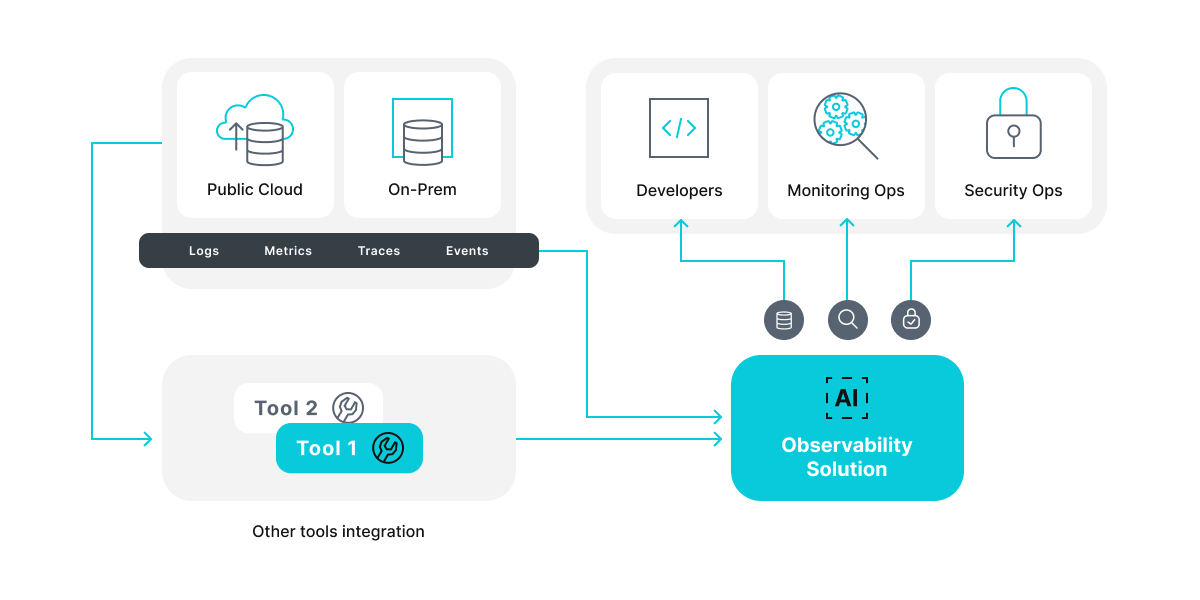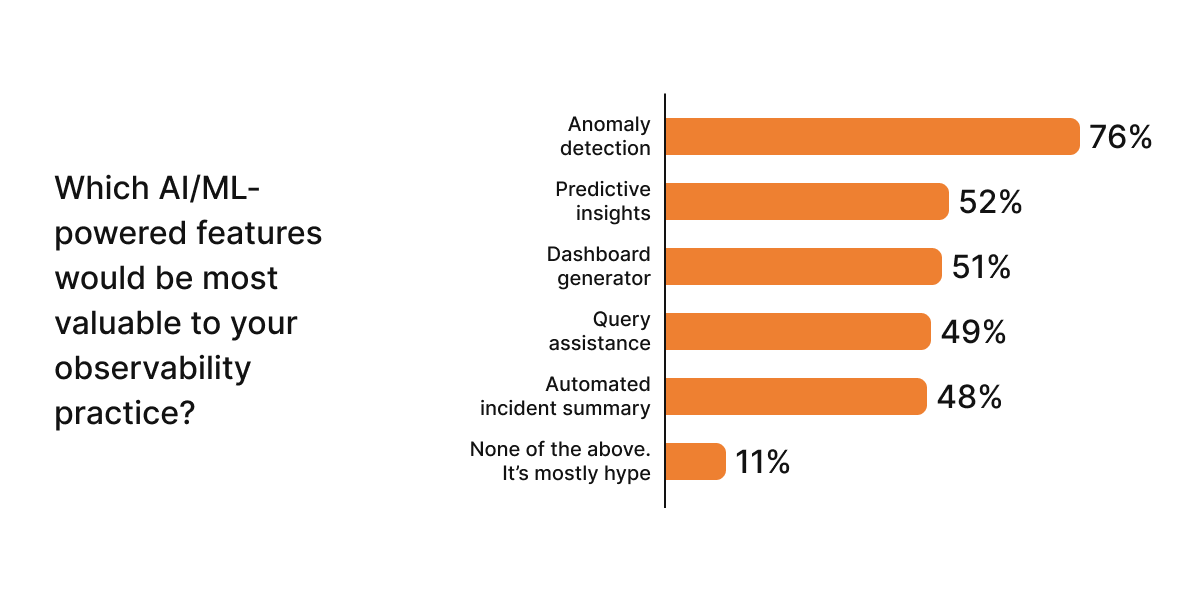The concept of observability emerged in the 1960s as part of industrial control theory. At its core, it involves understanding a system by examining its outputs. While this approach may initially seem similar to monitoring, it offers more than traditional alert-based monitoring methods. By offering a broader context about your systems, observability enables the discovery of root causes of potential problems instead of merely receiving notifications about their existence. This enables deeper insights that go beyond the predefined thresholds set by traditional monitoring tools.
Observability is based on three pillars: monitoring, logging, and tracing. The traditional approach involves using metrics to gain insight into systems or applications and consolidating the analysis of logs and metrics. While these practices still remain effective, the era of distributed environments requires reconsidering this approach to bring better results. In this article, we will explore the challenges organizations face when trying to implement observability in their environments, and the current trends aimed at mitigating them.
Observability Challenges
Complexity of Systems: Modern multi-cloud environments are becoming increasingly distributed. According to a study from 451 Research, 98% of enterprises use or plan to use at least two cloud providers, and 31% are using four or more. With services scattered across different platforms, organizations struggle to monitor operations and process the vast volumes of data they generate.
Overwhelming Data Volumes: As organizations track more services, they rely on numerous data sources for insights into their applications, infrastructure, and user experience. A survey by Dynatrace found that a typical enterprise uses an average of 10 different observability or monitoring tools, each generating vast amounts of data in different formats. Managing this deluge of data exceeds human capabilities.
Fragmented Vision: Many observability and monitoring tools operate in silos, making it difficult to construct a comprehensive view of a system’s state. Tool proliferation leads to challenges in processing disparate data from different sources, resulting in the absence of both a single source of truth and unified approach to data management.
High Data Storage Costs: Multiple tools and services generate vast amounts of data that must be stored and analyzed to provide an historical perspective on system performance, security, and health. Compliance requirements often necessitate long-term data retention, further driving up storage costs.
Lack of Experienced Staff: The Observability Pulse Report 2024 highlights that organizations are hindered by a lack of expertise on their way to achieve observability, with nearly 48% of respondents citing this as their primary challenge.
Vendor Lock-In: Organizations are concerned about their data being tied to specific vendors, viewing it as a potential liability. Specifically, they worry about the security and safety of their data under such conditions.
The reports conducted by observability market leaders indicate that organizations become increasingly aware of the importance of observability for their applications and infrastructure. However, in their pursuit to gain it, organizations grapple with scaling tools and processes, managing large volumes of data and the associated costs. Current observability trends are shaped by these challenges and aim to mitigate them.
Observability Trends
Coalescence of observability, security and IT tools
The explosion of signals produced by modern multicloud environments generates volumes of data that cannot be effectively handled by disparate tools. To manage this, organizations turn to intelligent observability platforms – holistic solutions that combine observability, security, and IT tools. Equipped with advanced automation, AI and analytics, these platforms facilitate efficient workflows by enabling automation of smaller tasks.

Operational principle of unified observability platform
This unified approach is also crucial for security, as it provides SecOps teams with broader context to understand their environments and distinguish important signals from noise. With real-time insights into system and application behaviors, security teams can be more proactive in identifying and addressing potential security issues before they escalate into major problems.
Advantages of using unified platforms include:
- Simplified data collection
- Single source of truth for data of different kinds
- Holistic view of your enterprise systems
- Automation of smaller tasks
- AI-based analytics
- Enhanced security measures
FinOps and reduction of cloud costs
According to the Observability Pulse survey, costs are a major challenge prompting organizations to reassess their observability strategies. To reduce cloud storage expenses, organizations are more selective about the monitoring data they collect. This demand for financial transparency has led observability platform providers to integrate advanced financial tools, allowing expenses to be correlated with profit centers.
AI’s role is important but secondary
Despite the excitement surrounding AI’s potential, its role in observability remains supplementary. Experts agree that while AI can reliably detect anomalies and alert staff, a human still needs to be at the center of the scheme connecting various elements of a complex system. The 2024 Observability Survey from Grafana Labs highlights a critical reevaluation of AI’s role, emphasizing the need to balance human expertise with AI-driven automation.
The downside of the widespread adoption of AIOps is that the observability market is flooded with similar products, with only a few companies standing out. Technology leaders predict that the maturity of AI, analytics, and automation capabilities will be crucial in selecting vendors and partners. Moreover, given the acute shortage of expert staff, advanced automation options will be a key differentiator for vendors. Organizations will seek solutions that automate time-consuming, low-skilled tasks or otherwise enhance the productivity of their existing teams.
The slide below displays the AI/ML features that organizations cite as the most sought-after in their observability practices:

Source: Grafana Labs’ 2024 Observability Survey
Boost of open standards
The impact of open source is growing as organizations seek to avoid vendor lock-in. According to Grafana Labs’ report, OpenTelemetry is emerging as a leader in application observability, while Prometheus remains the de facto standard in infrastructure observability.
According to Arijit Mukherji, a distinguished architect at Splunk and one of the contributors to their Observability Predictions 2024, open standards can revolutionize automation processes leading to bigger things and better results. Mukherji believes that as automation takes over smaller parts of human workflows, open standards help them interoperate with each other leading to bigger results.
Main Takeaways
- Organizations are increasingly adopting centralized observability solutions as they track more services.
- Costs remain a primary concern, driving organizations to adapt their observability strategies to reduce expenses.
- AI is gaining momentum as a powerful yet supportive technology in observability.
- The integration of security and observability tools provides a broader context, enabling proactive response to potential issues.
- Open standards are flourishing as organizations seek to avoid vendor lock-in.


